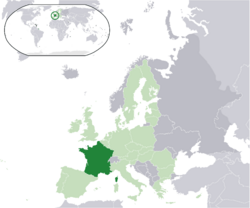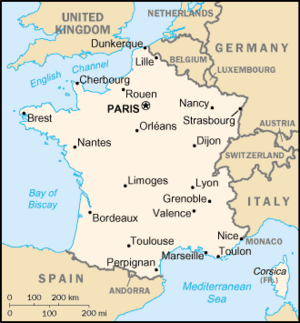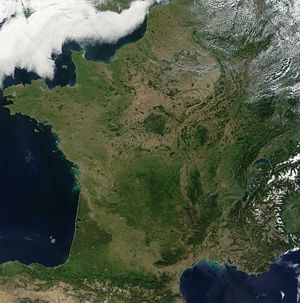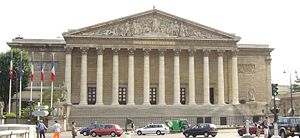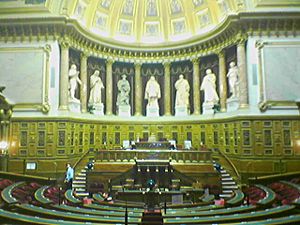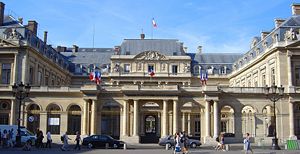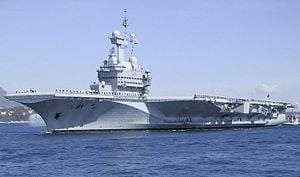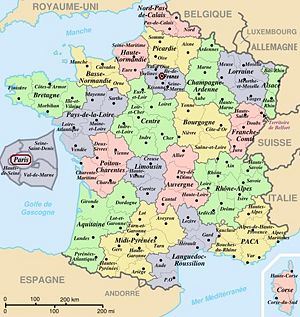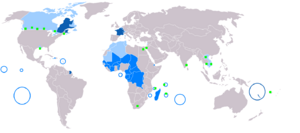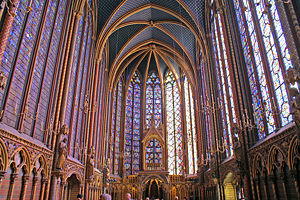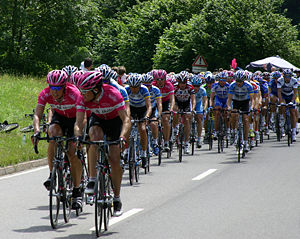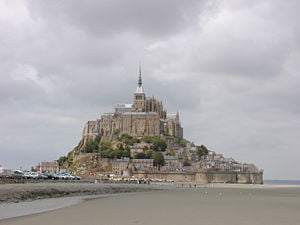Difference between revisions of "France" - New World Encyclopedia
Mike Butler (talk | contribs) |
Mike Butler (talk | contribs) |
||
| Line 173: | Line 173: | ||
[[Image:French Senate amphitheater 050917 162927.jpg|thumb|left|300px|The Senate's amphitheater.]] | [[Image:French Senate amphitheater 050917 162927.jpg|thumb|left|300px|The Senate's amphitheater.]] | ||
[[Image:DSC00652 conseil etat.jpg|thumb|left|300px|The Conseil d'État sits in the ''Palais Royal''.]] | [[Image:DSC00652 conseil etat.jpg|thumb|left|300px|The Conseil d'État sits in the ''Palais Royal''.]] | ||
| + | [[Image:Declaration of Human Rights.jpg|thumb|upright|left|300px|The basic principles that the French Republic must respect are found in the 1789 [[Declaration of the Rights of Man and of the Citizen]]]] | ||
| + | [[Image:Gaule96.jpg|thumb|left|300px|[[Charles de Gaulle (R 91)|Nuclear aircraft carrier ''Charles de Gaulle'']]]] | ||
The French Republic is a [[unitary state|unitary]] [[semi-presidential system|semi-presidential]] [[republic]] with strong democratic traditions. The [[Constitution of France|constitution]] of the Fifth Republic was approved by [[referendum]] on September 28, 1958. It greatly strengthened the authority of the executive in relation to parliament. The executive branch itself has two leaders: the [[President of the French Republic|President of the Republic]], who is elected directly by universal adult suffrage for a five-year term (formerly seven years) and is the Head of State, and the Government, led by the president-appointed Prime Minister. | The French Republic is a [[unitary state|unitary]] [[semi-presidential system|semi-presidential]] [[republic]] with strong democratic traditions. The [[Constitution of France|constitution]] of the Fifth Republic was approved by [[referendum]] on September 28, 1958. It greatly strengthened the authority of the executive in relation to parliament. The executive branch itself has two leaders: the [[President of the French Republic|President of the Republic]], who is elected directly by universal adult suffrage for a five-year term (formerly seven years) and is the Head of State, and the Government, led by the president-appointed Prime Minister. | ||
| Line 180: | Line 182: | ||
===Law=== | ===Law=== | ||
| − | |||
France uses a [[civil law (legal system)|civil legal]] system; that is, law arises primarily from written statutes; judges are not to make law, but merely to interpret it (though the amount of judge interpretation in certain areas makes it equivalent to [[case law]]). Basic principles of the [[rule of law]] were laid in the [[Napoleonic Code]]. In agreement with the principles of the [[Declaration of the Rights of Man and of the Citizen]] law should only prohibit actions detrimental to society. | France uses a [[civil law (legal system)|civil legal]] system; that is, law arises primarily from written statutes; judges are not to make law, but merely to interpret it (though the amount of judge interpretation in certain areas makes it equivalent to [[case law]]). Basic principles of the [[rule of law]] were laid in the [[Napoleonic Code]]. In agreement with the principles of the [[Declaration of the Rights of Man and of the Citizen]] law should only prohibit actions detrimental to society. | ||
| Line 190: | Line 191: | ||
===Foreign relations=== | ===Foreign relations=== | ||
| − | |||
{{see also|European Union|Latin Union|Francophonie|United Nations Security Council}} | {{see also|European Union|Latin Union|Francophonie|United Nations Security Council}} | ||
France is a member of the [[United Nations]] and serves as one of the permanent members of the [[U.N. Security Council]] with [[veto]] rights. It is also a member of the [[WTO]], the [[Secretariat of the Pacific Community]] (SPC), the [[Indian Ocean Commission]] (COI). It is an associate member of the [[Association of Caribbean States]] (ACS) and a leading member of the [[La Francophonie|International Francophone Organisation]] (OIF) of 51 fully or partly French-speaking countries. It hosts the headquarters of the [[Organisation for Economic Co-operation and Development|OECD]], [[UNESCO]], [[Interpol]], [[Alliance Base]] and the [[International Bureau of Weights and Measures|International Bureau for Weights and Measures]]. In 1953 France received a request from the [[United Nations]] to pick a coat of arms that would represent it internationally. Thus the French emblem was adopted and is currently used on passports. | France is a member of the [[United Nations]] and serves as one of the permanent members of the [[U.N. Security Council]] with [[veto]] rights. It is also a member of the [[WTO]], the [[Secretariat of the Pacific Community]] (SPC), the [[Indian Ocean Commission]] (COI). It is an associate member of the [[Association of Caribbean States]] (ACS) and a leading member of the [[La Francophonie|International Francophone Organisation]] (OIF) of 51 fully or partly French-speaking countries. It hosts the headquarters of the [[Organisation for Economic Co-operation and Development|OECD]], [[UNESCO]], [[Interpol]], [[Alliance Base]] and the [[International Bureau of Weights and Measures|International Bureau for Weights and Measures]]. In 1953 France received a request from the [[United Nations]] to pick a coat of arms that would represent it internationally. Thus the French emblem was adopted and is currently used on passports. | ||
| Line 197: | Line 197: | ||
===Military=== | ===Military=== | ||
| − | |||
The French [[armed forces]] comprises an army, navy, air force, and French Gendarmerie, a military force which acts as a National Rural Police and as a [[Military police]] for the entire French military. | The French [[armed forces]] comprises an army, navy, air force, and French Gendarmerie, a military force which acts as a National Rural Police and as a [[Military police]] for the entire French military. | ||
| Line 213: | Line 212: | ||
===Administrative divisions=== | ===Administrative divisions=== | ||
| − | |||
| − | |||
[[Image:France departements regions narrow.jpg|left|thumb|300px|The 22 regions and 96 departments of [[metropolitan France]] includes [[Corsica]] (''Corse'', lower right). Paris area is expanded (inset at left)]].]] | [[Image:France departements regions narrow.jpg|left|thumb|300px|The 22 regions and 96 departments of [[metropolitan France]] includes [[Corsica]] (''Corse'', lower right). Paris area is expanded (inset at left)]].]] | ||
France is divided into 26 administrative [[Regions of France|regions]]. Twenty two are in metropolitan France (21 are on the continental part of metropolitan France; one is the territorial collectivity of [[Corsica]]), and four are [[overseas region]]s. The regions are further subdivided into 100 [[Departments of France|departments]] which are numbered (mainly alphabetically). This number is used in postal codes and vehicle number plates amongst others. Four of these departments are found in the overseas regions and are simultaneously overseas regions and [[overseas department]]s and are an integral part of France (and the [[European Union]]) and thus enjoy a status similar to metropolitan departments. The 100 departments are subdivided into 341 [[Arrondissements of France|arrondissements]] which are, in turn, subdivided into 4032 [[Cantons of France|cantons]]. These cantons are then divided into 36,680 [[Communes of France|communes]], which are municipalities with an elected municipal council. There also exist 2588 [[Communes in France#Intercommunality|intercommunal]] entities grouping 33,414 of the 36,680 communes (i.e. 91.1% of all the communes). Three communes, Paris, Lyon and Marseille are also subdivided into 45 [[Municipal arrondissements of France|municipal arrondissements]]. | France is divided into 26 administrative [[Regions of France|regions]]. Twenty two are in metropolitan France (21 are on the continental part of metropolitan France; one is the territorial collectivity of [[Corsica]]), and four are [[overseas region]]s. The regions are further subdivided into 100 [[Departments of France|departments]] which are numbered (mainly alphabetically). This number is used in postal codes and vehicle number plates amongst others. Four of these departments are found in the overseas regions and are simultaneously overseas regions and [[overseas department]]s and are an integral part of France (and the [[European Union]]) and thus enjoy a status similar to metropolitan departments. The 100 departments are subdivided into 341 [[Arrondissements of France|arrondissements]] which are, in turn, subdivided into 4032 [[Cantons of France|cantons]]. These cantons are then divided into 36,680 [[Communes of France|communes]], which are municipalities with an elected municipal council. There also exist 2588 [[Communes in France#Intercommunality|intercommunal]] entities grouping 33,414 of the 36,680 communes (i.e. 91.1% of all the communes). Three communes, Paris, Lyon and Marseille are also subdivided into 45 [[Municipal arrondissements of France|municipal arrondissements]]. | ||
Revision as of 07:03, 6 November 2007
| République Française French Republic | |||||
| |||||
| Motto: Liberté, Égalité, Fraternité "Liberty, Equality, Fraternity" | |||||
| Anthem: "La Marseillaise" | |||||
|
Location of Metropolitan France (dark green)
– on the European continent (light green dark grey) – in the European Union (light green) | |||||
| Capital | Paris 48°52′N 2°19.59′E | ||||
|---|---|---|---|---|---|
| Largest city | capital | ||||
| Official languages | French | ||||
| Government | Semi-presidential unitary republic | ||||
| - President | Nicolas Sarkozy | ||||
| - Prime Minister | François Fillon | ||||
| Formation | |||||
| - French State | 843 (Treaty of Verdun) | ||||
| - Current constitution | 1958 (5th Republic) | ||||
| Accession to EU | March 25 1957 | ||||
| Area | |||||
| - Total [1] | 674843 km² (40th) 260558 sq mi | ||||
| Population | |||||
| - January 1, 2007 estimate | |||||
| - Total[1] | 64,102,140[3] | ||||
| - Metropolitan France | 61,538,322[2] | ||||
| - Density [4] | 113/km² 293/sq mi | ||||
| GDP (PPP) | 2006 estimate | ||||
| - Total | US $1.871 trillion | ||||
| - Per capita | US $30,100 | ||||
| GDP (nominal) | 2006 estimate | ||||
| - Total | US $2.232 trillion | ||||
| - Per capita | US $35,404 | ||||
| HDI (2004) | |||||
| Currency | Euro[5], CFP Franc[6] ( EUR, XPF)
| ||||
| Time zone | CET[4] (UTC+1) | ||||
| - Summer (DST) | CEST[4] (UTC+2) | ||||
| Internet TLD | .fr[7] | ||||
| Calling code | +33 | ||||
France, officially the French Republic, is a country whose metropolitan territory is located in Western Europe and that also comprises various overseas islands and territories located in other continents. Metropolitan France extends from the Mediterranean Sea to the English Channel and the North Sea, and from the Rhine to the Atlantic Ocean. French people often refer to Metropolitan France as L'Hexagone (The "Hexagon") because of the geometric shape of its territory.
In the 18th and 19th centuries, France built one of the largest colonial empires of the time, stretching across West Africa and Southeast Asia, prominently influencing the cultures and politics of the regions.
France is a developed country with the sixth-largest economy in the world.[8] France is the most visited country in the world, receiving over 79 million foreign tourists annually (including business visitors, but excluding people staying less than 24 hours in France).
France is one of the founding members of the European Union, and has the largest land area of all members. France is also a founding member of the United Nations, and a member of the Francophonie, the G8, and the Latin Union. It is one of the five permanent members of the United Nations Security Council; it is also an acknowledged nuclear power.
Origin of the name
The name "France" comes from Latin Francia, which literally means "land of the Franks" or "Frankland". One theory as to the origin of the name is that it is derived from the Proto-Germanic word frankon which translates as javelin or lance as the throwing axe of the Franks was known as a francisca. Another proposed etymology is that in an ancient Germanic language, Frank means free as opposed to slave. It is probable that the word is derived from the ethnic name of the Franks, the connection being that only the Franks, as the conquering class, had the status of freemen. In German, France is still called Frankreich, which literally means "Realm of the Franks". In order to distinguish from the Frankish Empire of Charlemagne, Modern France is called Frankreich, while the Frankish Realm is called Frankenreich.
Geography
France is bordered by Belgium, Luxembourg, Germany, Switzerland, Italy, Monaco, Andorra, and Spain. France is also linked to the United Kingdom by the Channel Tunnel, which passes underneath the English Channel. Corsica lies off the Mediterranean coast. Due to its overseas departments, France also shares land borders with Brazil and Suriname (bordering French Guiana), and the Netherlands Antilles (bordering Saint-Martin).
While Metropolitan France is located in Western Europe, France also has a number of territories in North America, the Caribbean, South America, the southern Indian Ocean, the Pacific Ocean, and Antarctica. These territories have varying forms of government ranging from overseas department to overseas collectivity.
Metropolitan France covers 213,010 square miles (551,695 square kilometers) making it the largest country in area in the European Union, being only slightly larger than Spain, or slightly less than the size of Texas, in the United States.
France possesses a wide variety of landscapes, from coastal plains in the north and west to mountain ranges of the Alps in the south-east, the Massif Central in the south-central and Pyrenees in the south-west. At 15,770 feet (4807 meters) above sea-level, the highest point in Western Europe, Mont Blanc, is situated in the Alps on the border between France and Italy.
Metropolitan France lies within the northern temperate zone. The north and northwest have a temperate climate, however, a combination of maritime influences, latitude and altitude produce a varied climate in the rest of Metropolitan France. In the south-east a Mediterranean climate prevails. In the west, the climate is predominantly oceanic with a high level of rainfall, mild winters and cool summers. Inland the climate becomes more continental with hot, stormy summers, colder winters and less rain. The climate of the Alps and other mountainous regions are mainly alpine in nature with the number of days with temperatures below freezing over 150 per year and snowcover lasting for up to six months.
France also has extensive river systems such as the Loire, the Garonne, the Seine and the Rhône, which divides the Massif Central from the Alps and flows into the Mediterranean sea at the Camargue, the lowest point in France (2 m / 6.5 ft below sea level).
A major divide, running from the southern end of the Vosges down the eastern and southeastern edge of the Massif Central to the Noire Mountains, is the source of most of the rivers of the larger, western part of the country, including the Seine and the Loire. Other main rivers are the Garonne, flowing from the Pyrenees, and the Rhône and the Rhine, originating in the Alps.
France has forests of has chestnut and beech in the Massif Central, juniper and dwarf pine in the subalpine zone, with pine forests and various oaks in the south. Eucalyptus from Australia and dwarf pines abound in Provence, while olive trees, vines, mulberry, fig trees, as well as laurel, wild herbs, and maquis scrub grow in the Mediterranean area.
Brown bear, chamois, marmot, and alpine hare live in the Pyrenees and the Alps. Polecats, marten, wild boar, and various deer live in the forests. Hedgehog, shrew, fox, weasel, bat, squirrel, badger, rabbit, mouse, otter, and beaver are common. Birds include warblers, thrushes, magpies, owls, buzzards, and gulls. There are storks in Alsace, eagles and falcons in the mountains, pheasants and partridge in the south. Flamingos, terns, buntings, herons, and egrets are found in the Mediterranean zone. The rivers contain eels, pike, perch, carp, roach, salmon, and trout, while lobster and crayfish are found in the Mediterranean.
France's natural resources includes coal, iron ore, bauxite, fish, timber, potash, and zinc.
Natural hazards include flooding, avalanches, and forest fires. Environmental issues include forest damage from acid rain, air pollution from industrial and vehicle emissions, water pollution from urban wastes, and agricultural run-off.
Paris, the capital city, is situated on the River Seine, in northern France, at the heart of the Île-de-France region. The City of Paris has an estimated population of 2,153,600 within its administrative limits. The Paris unité urbaine (similar to the North American "urban area") is an area of unbroken urban growth that extends well beyond the administrative city limits and has a population of 9.93 million. An important settlement for more than two millennia, Paris is today one of the world's leading business and cultural centres, and its influence in politics, education, entertainment, media, fashion, science and the arts all contribute to its status as one of the world's major global cities.
History
--- from "origin of the name" The Merovingian kings claimed descent of their dynasty from the Sicambri, a Scythian or Cimmerian tribe, asserting that this tribe had changed their name to "Franks" in 11 B.C.E., following their defeat and relocation by Drusus, under the leadership of a certain chieftain called Franko, although they had actually come from present day Netherlands, Lower Saxony, and possibly, ultimately Scandinavia.
The word "Frank" had been loosely used from the fall of Rome to the Middle Ages, yet from Hugh Capet's coronation as "King of the Franks" ("Rex Francorum") it became used to strictly refer to the Kingdom of Francia, which would become France. The Capetian Kings were descended from the Robertines, who had produced two Frankish kings, and previously held the title of "Duke of the Franks" ("dux francorum"). This Frankish duchy encompassed most of modern northern France but because the royal power was sapped by regional princes the term was then applied to the royal demesne as shorthand. It was finally the name adopted for the entire Kingdom as central power was affirmed over the entire kingdom.[9]
---
Rome to revolution
The borders of modern France are approximately the same as those of ancient Gaul, which was inhabited by Celtic Gauls. Gaul was conquered for Rome by Julius Caesar in the 1st century B.C.E., and the Gauls eventually adopted Roman speech (Latin, from which the French language evolved) and Roman culture. Christianity took root in the 2nd century and 3rd century AD, and became so firmly established by the fourth and fifth centuries that St. Jerome wrote that Gaul was the only region "free from heresy".
In the 4th century AD, Gaul's eastern frontier along the Rhine was overrun by Germanic tribes, principally the Franks, from whom the ancient name of "Francie" was derived. The modern name "France" derives from the name of the feudal domain of the Capetian Kings of France around Paris. The Franks were the first tribe among the Germanic conquerors of Europe after the fall of the Roman Empire to convert to Catholic Christianity rather than Arianism (their King Clovis did so in 498); thus France obtained the title "Eldest daughter of the Church" (La fille ainée de l'Église), and the French would adopt this as justification for calling themselves "the Most Christian Kingdom of France".
Existence as a separate entity began with the Treaty of Verdun (843), with the division of Charlemagne's Carolingian empire into East Francia, Middle Francia and Western Francia. Western Francia approximated the area occupied by modern France and was the precursor to modern France.
The Carolingians ruled France until 987, when Hugh Capet, Duke of France and Count of Paris, was crowned King of France. His descendants, the Direct Capetians, the House of Valois and the House of Bourbon, progressively unified the country through a series of wars and dynastic inheritance. The monarchy reached its height during the 17th century and the reign of Louis XIV. At this time France possessed the largest population in Europe (see Demographics of France) and had tremendous influence over European politics, economy, and culture. France obtained many overseas possessions in the Americas, Africa and Asia.
Monarchy to republic
The monarchy ruled France until the French Revolution, in 1789. King Louis XVI and his wife, Marie Antoinette, were executed, along with thousands of other French citizens. After a series of short-lived governmental schemes, Napoleon Bonaparte seized control of the Republic in 1799, making himself First Consul, and later Emperor of what is now known as the First French Empire (1804–1814). In the course of several wars, his armies conquered most of continental Europe, with members of the Bonaparte family being appointed as monarchs of newly established kingdoms.
Following Napoleon's final defeat in 1815 at the Battle of Waterloo, the French monarchy was re-established, but with new constitutional limitations. In 1830, a civil uprising established the constitutional July Monarchy, which lasted until 1848. The short-lived Second Republic ended in 1852 when Louis-Napoléon Bonaparte proclaimed the Second French Empire. Louis-Napoléon was unseated following defeat in the Franco-Prussian war of 1870 and his regime was replaced by the Third Republic.
France had colonial possessions, in various forms, since the beginning of the 17th century until the 1960s. In the 19th and 20th centuries, its global colonial empire was the second largest in the world behind the British Empire. At its peak, between 1919 and 1939, the second French colonial empire extended over 12,347,000 square kilometres (4,767,000 sq mi) of land. Including metropolitan France, the total area of land under French sovereignty reached 12,898,000 square kilometres (4,980,000 sq mi) in the 1920s and 1930s, which is 8.6% of the world's land area.

Though ultimately a victor in World War I, France suffered enormous human and material losses that weakened it for decades to come. The 1930s were marked by a variety of social reforms introduced by the Popular Front government. At the start of World War II, France held a series of unsuccessful rescue campaigns in Norway, Belgium and The Netherlands from 1939 to 1940. Upon the May-June 1940 Nazi German blitzkrieg and its Fascist Italian support, France's political leadership disregarded Churchill's proposal of a Franco-British Union and signed the Second Armistice at Compiègne surrender on June 22 1940. The Germans established a puppet regime under Marshal Philippe Pétain known as Vichy France, which pursued a policy of collaboration with Nazi Germany. The regime's opponents formed the Free French Forces outside of France and the French Resistance inside. France was liberated with the joint effort of the United States, the United Kingdom, Canada, the Free French Forces and the French resistance in 1944. Soon the Nouvelle Armée Française ("new French army") was established with the massive help of US-built material and equipment, and pursued the fight along the Allies in various battles including the campaign of Italy.
The French Fourth Republic was established after World War II and struggled to maintain its economic and political status as a dominant nation state. France attempted to hold on to its colonial empire, but soon ran into trouble. The half-hearted 1946 attempt at regaining control of French Indochina resulted in the First Indochina War, which ended in French defeat at the Battle of Dien Bien Phu in 1954. Only months later, France faced a new, even harsher conflict in its oldest major colony, Algeria.
The debate over whether or not to keep control of Algeria, then home to over one million European settlers, wracked the country and nearly led to civil war. In 1958, the weak and unstable Fourth Republic gave way to the Fifth Republic, which contained a strengthened Presidency. In the latter role, Charles de Gaulle managed to keep the country together while taking steps to end the war. The Algerian War and Franco-French civil war that resulted in the capital Algiers, was concluded with peace negotiations in 1962 that led to Algerian independence.
In recent decades, France's reconciliation and cooperation with Germany have proved central to the political and economic integration of the evolving European Union, including the introduction of the euro in January 1999. France has been at the forefront of the European Union member states seeking to exploit the momentum of monetary union to create a more unified and capable European Union political, defence, and security apparatus. However, the French electorate voted against ratification of the European Constitutional Treaty in May 2005.
Government and politics

The French Republic is a unitary semi-presidential republic with strong democratic traditions. The constitution of the Fifth Republic was approved by referendum on September 28, 1958. It greatly strengthened the authority of the executive in relation to parliament. The executive branch itself has two leaders: the President of the Republic, who is elected directly by universal adult suffrage for a five-year term (formerly seven years) and is the Head of State, and the Government, led by the president-appointed Prime Minister.
The French parliament is a bicameral legislature comprising a national assembly (Assemblée Nationale) and a senate. The national assembly deputies represent local constituencies and are directly elected for five-year terms. The assembly has the power to dismiss the cabinet, and thus the majority in the Assembly determines the choice of government. Senators are chosen by an electoral college for six-year terms (originally nine-year terms), and one half of the seats are submitted to election every three years starting in September 2008. The Senate's legislative powers are limited; in the event of disagreement between the two chambers, the National Assembly has the final say, except for constitutional laws and lois organiques (laws that are directly provided for by the constitution) in some cases. The government has a strong influence in shaping the agenda of Parliament.
French politics are characterised by two politically opposed groupings: one left-wing, centred around the French Socialist Party, and the other right-wing, centred previously around the Rally for the Republic(RPR)]] and now its successor the Union for a Popular Movement. The executive branch is currently composed mostly of the UPM.
Law
France uses a civil legal system; that is, law arises primarily from written statutes; judges are not to make law, but merely to interpret it (though the amount of judge interpretation in certain areas makes it equivalent to case law). Basic principles of the rule of law were laid in the Napoleonic Code. In agreement with the principles of the Declaration of the Rights of Man and of the Citizen law should only prohibit actions detrimental to society.
French law is divided into two principal areas: private law and public law. Private law includes, in particular, civil law and criminal law. Public law includes, in particular, administrative law and constitutional law. However, in practical terms, French law comprises three principal areas of law: civil law; criminal law and administrative law.
France does not recognise religious law, nor does it recognise religious beliefs or morality as a motivation for the enactment of prohibitions. As a consequence, France has long had neither blasphemy laws nor sodomy laws (the latter being abolished in 1791). However "offences against public decency" (contraires aux bonnes mœurs) or breach of the peace (trouble à l'ordre public) have been used to repress public expressions of homosexuality or street prostitution.
Laws can only address the future and not the past (ex post facto laws are prohibited); and to be applicable, laws must be officially published in the Journal Officiel de la République Française.
Foreign relations
- See also: European Union , Latin Union , Francophonie , and United Nations Security Council
France is a member of the United Nations and serves as one of the permanent members of the U.N. Security Council with veto rights. It is also a member of the WTO, the Secretariat of the Pacific Community (SPC), the Indian Ocean Commission (COI). It is an associate member of the Association of Caribbean States (ACS) and a leading member of the International Francophone Organisation (OIF) of 51 fully or partly French-speaking countries. It hosts the headquarters of the OECD, UNESCO, Interpol, Alliance Base and the International Bureau for Weights and Measures. In 1953 France received a request from the United Nations to pick a coat of arms that would represent it internationally. Thus the French emblem was adopted and is currently used on passports.
French foreign policy has been largely shaped by membership of the European Union, of which it was a founding member. In the 1960s, France sought to exclude the British from the organization, seeking to build its own standing in continental Europe. Since the 1990s, France has developed close ties with reunified Germany to become the most influential driving force of the EU, but consequently rivaling the U.K. and limiting the influence of newly-inducted East European nations. France is a member of the North Atlantic Treaty Organization, but under President de Gaulle, it excluded itself from the joint military command to avoid the supposed domination of its foreign and security policies by U.S. political and military influence. In the early 1990s, the country drew considerable criticism from other nations for its atmospheric nuclear tests in Polynesia. France vigorously opposed the 2003 invasion of Iraq, straining bilateral relations with the U.S. and the U.K. France retains strong political and economic influence in its former African colonies and has supplied economic aid and troops for peace-keeping missions in the Ivory Coast and Chad.
Military
The French armed forces comprises an army, navy, air force, and French Gendarmerie, a military force which acts as a National Rural Police and as a Military police for the entire French military.
Since the Algerian War, conscription was steadily reduced and was finally suspended in 2001 by Jacques Chirac. The total number of military personnel is approximately 359,000. France spends 2.6 percent of its GDP on defence, slightly more than the United Kingdom (2.4 percent), and is the highest in the European Union where defence spending is generally less than 1.5 percent of GDP. Together they account for 40% of EU defence spending. About 10% of France's defence budget goes towards its nuclear weapons. A significant part of French military equipment is made in France. Examples include the Rafale fighter, the Charles de Gaulle aircraft carrier, the Exocet missile, and the Leclerc tank.
Some weaponry, like the E-2 Hawkeye or the E-3 Sentry was bought from the United States. Despite withdrawing from the Eurofighter project, France is actively investing in European joint projects such as the Eurocopter Tiger, multipurpose frigates, the UCAV demonstrator nEUROn and the Airbus A400M. France is a major arms seller as most of its arsenal's designs are available for the export market with the notable exception of nuclear powered devices.
The French nuclear force consisted, in 2007, of four submarines equipped with M45 ballistic missiles. The French dissuasion force uses the Mirage 2000N; it is a variant of the Mirage 2000 and thus is designed to deliver nuclear strikes. Other nuclear devices like the Plateau d'Albion's Intercontinental ballistic missiles and the short range Hadès missiles have been disarmed. With 350 nuclear heads stockpiled France is the world's third largest nuclear power.
The Marine Nationale is regarded as one of the world's most powerful navies. The professional compendium flottes de combats, in its 2006 edition, ranked it world's sixth biggest navy after the American, Russian, Chinese, British and Japanese navies.
The Armée de Terre employs 133,500 people, it is very famous for the Légion Etrangère though the French special forces aren't the Legion but the Dragons Parachutistes and the Marines Parachutistes. The French assault rifle is the FAMAS and future infantry combat system is the Félin.
The Armée de l'Air is the oldest and first professional air force worldwide. It still today retains a significant capacity. It uses mainly two aircraft fighters: the older Mirage F1 and the more recent Mirage 2000. The later model exists in a ground attack version called the Mirage2000D. The highly modern Rafale is in deployment in both the French air force and navy.
Administrative divisions
.]]
France is divided into 26 administrative regions. Twenty two are in metropolitan France (21 are on the continental part of metropolitan France; one is the territorial collectivity of Corsica), and four are overseas regions. The regions are further subdivided into 100 departments which are numbered (mainly alphabetically). This number is used in postal codes and vehicle number plates amongst others. Four of these departments are found in the overseas regions and are simultaneously overseas regions and overseas departments and are an integral part of France (and the European Union) and thus enjoy a status similar to metropolitan departments. The 100 departments are subdivided into 341 arrondissements which are, in turn, subdivided into 4032 cantons. These cantons are then divided into 36,680 communes, which are municipalities with an elected municipal council. There also exist 2588 intercommunal entities grouping 33,414 of the 36,680 communes (i.e. 91.1% of all the communes). Three communes, Paris, Lyon and Marseille are also subdivided into 45 municipal arrondissements.
The regions, departments and communes are all known as territorial collectivities, meaning they possess local assemblies as well as an executive. Arrondissements and cantons are merely administrative divisions. However, this was not always the case. Until 1940, the arrondissements were also territorial collectivities with an elected assembly, but these were suspended by the Vichy regime and definitely abolished by the Fourth Republic in 1946. Historically, the cantons were also territorial collectivities with their elected assemblies.
The French Republic also has six overseas collectivities, one sui generis collectivity (New Caledonia), and one overseas territory. Overseas collectivities and territories form part of the French Republic, but do not form part of the European Union or its fiscal area. The Pacific territories continue to use the Pacific franc whose value is linked to that of the euro. In contrast, the four overseas regions used the French franc and now use the euro.
France also maintains control over a number of small non-permanently inhabited islands in the Indian Ocean and the Pacific Ocean: Bassas da India, Clipperton Island, Europa Island, Glorioso Islands, Juan de Nova Island, Tromelin Island.
Overseas departments have the same political status as metropolitan departments. They includeGuadeloupe, Martinique, French Guiana, and Réunion, all since 1946.
Economy
--- from geog However, France possesses the second-largest Exclusive Economic Zone (EEZ) in the world, covering 11,035,000 square kilometres (4,260,000 sq mi), approximately 8% of the total surface of all the EEZs of the world, just behind the United States (11,351,000 km² / 4,383,000 sq mi) and ahead of Australia (8,232,000 km² / 3,178,000 sq mi). ---
France's economy combines extensive private enterprise (nearly 2.5 million companies registered) with substantial (though declining) government intervention (see dirigisme). The government retains considerable influence over key segments of infrastructure sectors, with majority ownership of railway, electricity, aircraft, and telecommunication firms. It has been gradually relaxing its control over these sectors since the early 1990s. The government is slowly selling off holdings in France Télécom, Air France, as well as the insurance, banking, and defence industries.
A member of the G8 group of leading industrialised countries, it is ranked as the sixth largest economy in the world in 2005, behind the United States, Japan, Germany, The People's Republic of China and the United Kingdom. France joined 11 other EU members to launch the Euro on January 1 1999, with euro coins and banknotes completely replacing the French franc (₣) in early 2002. According to the OECD, in 2004 France was the world's fifth-largest exporter and the fourth-largest importer of manufactured goods. In 2003, France was the 2nd-largest recipient of foreign direct investment among OECD countries at $47 billion, ranking behind Luxembourg (where foreign direct investment was essentially monetary transfers to banks located in that country) but above the United States ($39.9 billion), the United Kingdom ($14.6 billion), Germany ($12.9 billion), or Japan ($6.3 billion). In the same year, French companies invested $57.3 billion outside of France, ranking France as the second most important outward direct investor in the OECD, behind the United States ($173.8 billion), and ahead of the United Kingdom ($55.3 billion), Japan ($28.8 billion) and Germany ($2.6 billion).
In the 2005 edition of OECD in Figures, the OECD also noted that France leads the G7 countries in terms of productivity (measured as GDP per hour worked).[10] In 2004, the GDP per hour worked in France was $47.7, ranking France above the United States ($46.3), Germany ($42.1), the United Kingdom ($39.6), or Japan ($32.5).[11]
Despite figures showing a higher productivity per hour worked than in the US, France's GDP per capita is significantly lower than the US GDP per capita, being in fact comparable to the GDP per capita of the other European countries, which is on average 30% below the US level. The reason for this is that a much smaller percentage of the French population is working compared to the US, which lowers the GDP per capita of France, despite its higher productivity. In fact, France has one of the lowest percentages of its population aged 15-64 years at work among the OECD countries. In 2004, 68.8% of the French population aged 15-64 years was in employment, compared to 80.0% in Japan, 78.9% in the UK, 77.2% in the US, and 71.0% in Germany.[12] This phenomenon is the result of almost thirty years of massive unemployment in France, which has led to three consequences reducing the size of the working population: about 9% of the active population is without a job; students delay as long as possible their entry into labour market; and finally, the French government gives various incentives to workers to retire in their early 50s, though these are now receding.
As many economists have stressed repeatedly over the years, the main issue with the French economy is not an issue of productivity. In their opinion, it is an issue of structural reforms, in order to increase the size of the working population in the overall population. Liberal and Keynesian economists have different answers to that issue. Lower working hours and the reluctance to reform the labour market are mentioned as weak spots of the French economy in the view of the right and lack of government policies fostering social justice by the left. Recent government attempts at adjusting the youth labour market, to combat unemployment, have met with fierce resistance.
With 79.1 million foreign tourists in 2006,[13] France is ranked as the first tourist destination in the world, ahead of Spain (55.6 million in 2005) and the United States (49.4 million in 2005). This 79.1 million figure excludes people staying less than 24 hours in France, such as northern Europeans crossing France on their way to Spain or Italy during the Summer. France features cities of high cultural interest (Paris being the foremost), beaches and seaside resorts, ski resorts, and rural regions that many enjoy for their beauty and tranquillity (green tourism). Aside of casual tourism France attracts a lot of religious pilgrims to Lourdes, a town in the Hautes-Pyrénées département, that hosts a few million tourists a year.
France has an important aerospace industry led by the European consortium Airbus, and is the only European power (excluding Russia) to have its own national spaceport (Centre Spatial Guyanais). France is also the most energy independent Western country due to heavy investment in nuclear power, which also makes France the smallest producer of carbon dioxide among the seven most industrialised countries in the world. As a result of large investments in nuclear technology, most of the electricity produced in the country is generated by nuclear power plants (78.1% in 2006,[14] up from only 8% in 1973, 24% in 1980, and 75% in 1990).
Large tracts of fertile land, the application of modern technology, and EU subsidies have combined to make France the leading agricultural producer and exporter in Europe. Wheat, poultry, dairy, beef, and pork, as well as an internationally recognised foodstuff and wine industry are primary French agricultural exports. EU agriculture subsidies to France total almost $14 billion.
Since the end of the Second World War the government made efforts to integrate more and more with Germany, both economically and politically. Today the two countries form what is often referred to as the "core" countries in favour of greater integration of the European Union.
Transportation
The railway network in France totals 31,840 kilometres (19,784 mi), the most extensive in Western Europe, and is operated by the SNCF. High speed trains include the Thalys, the Eurostar and the TGV, which travels at 320 km/h (200 mph) in commercial use. The Eurostar, along with the Eurotunnel Shuttle, connects with the United Kingdom through the Channel Tunnel. Rail connections exist to all other neighbouring countries in Europe, except Andorra. Intra-urban connections are also well developed with both underground services and tramway services complementing bus services.
There is approximately 893,300 kilometres (555,070 mi) of serviceable roadway in France. There is no annual registration fee or road tax; however, motorway usage is through tolls except in the vicinity of large communes. The new car market is dominated by national brands such as Renault (27% of cars sold in France in 2003), Peugeot (20.1%) and Citroën (13.5%).[15] Over 70% of new cars sold in 2004 had diesel engines, far more than contained petrol or LPG engines.[16] France possesses the world's tallest road bridge: the Millau Viaduct, and has built many important bridges such as the Pont de Normandie.
There are approximately 478 airports in France, including landing fields. The most important and largest of these is Charles de Gaulle International Airport just outside Paris; it is also the main hub of Air France, the French national airline. There are ten major ports in France, the largest of which is in Marseille, which also is the largest bordering the Mediterranean Sea. 14,932 kilometres (9,278 mi) of waterways traverse France.
Demography
Population
With an estimated population of 64 million people, France is the 23rd most populous country in the world. France's largest cities are Paris, Marseille, Lyon, Toulouse, Nice, and Nantes.
In 2003, France's natural population growth (excluding immigration) was responsible for almost all natural population growth in the European Union. In 2004, population growth was 0.68% and then in 2005 birth and fertility rates continued to increase. The natural increase of births over deaths rose to 299,800 in 2006. The lifetime fertility rate rose to 2.00 in 2007, from 1.92 in 2004.[1]
In 2004, a total of 140,033 people immigrated to France. Of them, 90,250 were from Africa and 13,710 from Europe.[17] In 2005, immigration level fell slightly to 135,890.[18] France is an ethnically diverse nation. According to the French National Institute for Statistics and Economic Studies, it has an estimated 4.9 million foreign-born immigrants, of which 2 million have acquired French citizenship.[19] France is the leading asylum destination in Western Europe with an estimated 50,000 applications in 2005 (a 15% decrease from 2004).[20] The European Union allows free movement between the member states. While the UK (along with Ireland) did not impose restrictions, France put in place controls to curb Eastern European migration.
A perennial political issue concerns rural depopulation. Over the period 1960-1999 fifteen rural départements experienced a decline in population. In the most extreme case, the population of Creuse fell by 24%.
Ethnicity
Religion
France is a secular country as freedom of religion is a constitutional right, although some religious doctrines such as Scientology, Children of God, the Unification Church, and the Order of the Solar Temple are considered cults. According to a January 2007 poll by the Catholic World News:[21][22] 51% identified as being Catholics, 31% identified as being agnostics or atheists. (Another poll [23] concluded that 27% identified as being atheists.), 10% identified as being from other religions or being without opinion, 4% identified as Muslim, 3% identified as Protestant, 1% identified as Jewish.
According to the most recent Eurobarometer Poll 2005,[24] 34% of French citizens responded that "they believe there is a god", whereas 27% answered that "they believe there is some sort of spirit or life force" and 33% that "they do not believe there is any sort of spirit, god, or life force".
In France, 32% declare themselves to be atheists, with an additional 32% declaring themselves agnostic[25]. The current Jewish community in France numbers around 600,000 according to the World Jewish Congress and is largest in Europe. Estimates of the number of Muslims in France vary widely. According to the 1999 French census returns, there were only 3.7 million people of "possible Muslim faith" in France (6.3% of the total population). There are an estimated 200,000 to 1 million illegal immigrants in France.
The concept of laïcité exists in France and because of this the French government is legally prohibited from recognising any religion (except for legacy statutes like those of military chaplains and Alsace-Moselle). Instead, it merely recognises religious organisations, according to formal legal criteria that do not address religious doctrine. Conversely, religious organisations should refrain from intervening in policy-making. Tensions occasionally erupt about alleged discrimination against minorities, especially against Muslims (see Islam in France).
Language
According to Article 2 of the Constitution, French is the sole official language of France since 1992. This makes France the only Western European nation (excluding microstates) to have only one officially recognised language. However, 77 regional languages are also spoken, in metropolitan France as well as in the overseas departments and territories. Until recently, the French government and state school system discouraged the use of any of these languages, but they are now taught to varying degrees at some schools.[26] Other languages, such as Portuguese, Italian, Maghrebi Arabic and several Berber languages are spoken by immigrants.
Public health
The French healthcare system was ranked first worldwide by the World Health Organization in 1997.[27] It is almost entirely free for people affected by chronic diseases (Affections de longues durées) such as cancers, AIDS or Cystic Fibrosis. Average life expectancy at birth is 79.73 years.
As of 2003, there are approximately 120,000 inhabitants of France who are living with AIDS [2]
France, as all EU countries, is under an EU directive to reduce sewage discharge to sensitive areas. As of 2006, France is only 40 per cent in compliance with this directive, placing it as one of the lowest achieving countries within the EU with regard to this wastewater treatment standard [3].
Men and women
Marriage and the family
Education
Class
Culture

- Académie française
- French art
- Cuisine of France
- Cinema of France
- Music of France
- Social structure of France
- Education in France
- Holidays in France
- List of French people
Architecture
There is, technically speaking, no architecture named French Architecture, although that has not always been true. Gothic Architecture's old name was French Architecture (or Opus Francigenum). The term "Gothic" appeared later as a stylistic insult and was widely adopted. Northern France is the home of some of the most important Gothic cathedrals and basilicas, the first of these being the Saint Denis Basilica (used as the royal necropolis); other majestuous and important French Gothic cathedrals are Notre-Dame de Chartres and Notre-Dame d'Amiens. The kings were crowned in another important Gothic church: Notre-Dame de Reims. Aside from churches, Gothic Architecture had been used for many religious palaces, the most important one being the Palais des Papes in Avignon.
During the Middle Ages, fortified castles were built by feudal nobles to mark their powers against their rivals. When King Philip II took Rouen from King John, for example, he demolished the ducal castle to build a bigger one. Fortified cities were also common, unfortunately most French castles did not survive the passage of time. This is why Richard Lionheart's castle -Château-Gaillard- was demolished as well as the Château de Lusignan. Some important French castles that survived are Chinon Castle, Château d'Angers, the massive Château de Vincennes and the so called Cathar castles.
Before the appearance of this architecture France had been using romanesque architecture like most of Western Europe (with the exception of the Iberian Peninsula, which used Mooresque architecture). Some of the greatest examples of Romanesque Churches in France are the Saint Sernin Basilica in Toulouse and the remains of the Cluniac Abbey (largely destroyed during the Revolution and the Napoleonic Wars).
The end of the Hundred Years' War marked an important stage in the evolution of French architecture. It was the time of the French Renaissance and several artists from Italy and Spain were invited to the French court; many residential palaces, Italian-inspired, were built, mainly in the Loire Valley. Such residential castles were the Château de Chambord, the Château de Chenonceau, or the Château d'Amboise. Following the renaissance and the end of the Middle Ages, Baroque Architecture replaced the gothic one. However, in France, baroque architecture found a greater success in the secular domain than in the religious one.[28] In the secular domain the Palace of Versailles has many baroque features. Jules Hardouin Mansart can be said to be the most influential French architect of the baroque style, with his very famous baroque dome of Les Invalides. Some of the most impressive provincial baroque architecture is found in places that were not yet French such as the Place Stanislas in Nancy. On the military architectural side Vauban designed some of the most efficient fortresses of Europe and became a very influential military architect.
After the French revolution the Republicans favoured Neoclassicism although neoclassicism was introduced in France prior to the revolution with such building as the Parisian Pantheon or the Capitole de Toulouse. Built during the French Empire the Arc de Triomphe and Sainte Marie-Madeleine represent this trend the best.
Under Napoleon III a new wave of urbanism and architecture was given birth. If some very extravagant buildings such as the neo-baroque Palais Garnier were built, the urban planing of the time was very organised and rigorous. For example Baron Haussmann rebuilt Paris. These times also saw a strong Gothic-Revival trend across Europe, in France the associated architect was Eugène Viollet-le-Duc. In the late 19th century Gustave Eiffel designed many bridges (like the Garabit viaduct) and remains one of the most influential bridge designer of his time, although he is best remembered for the Eiffel Tower.
In the 20th century the Swiss Architect Le Corbusier designed several buildings in France. More recently French architects have combined both modern and old architectural styles. The Louvre Pyramid is a good example of modern architecture added to an older building. Certainly the most difficult buildings to integrate within French cities are skyscrapers, as they are visible from afar. France's largest financial district is La Defense, where a significant number of skyscrapers are located. Other massive buildings that are a challenge to integrate into their environment are large bridges; a good example of the way this has been done is the Millau Viaduct. Some famous modern French architects include Jean Nouvel or Paul Andreu.
Art
Cinema
Cuisine
Literature
French literature tracks its origins back to the Middle Ages. French was not yet a uniform language but was divided into several dialects (mainly: northern oïl, southern oc dialects). Each writer used his own spelling and grammar. Several French mediaeval texts are not signed- such is the case with Tristan and Iseult, or with Lancelot and the Holy Grail, among many others. A significant part of mediaeval French poetry and literature was inspired by the Matter of France, such as the The Song of Roland and the various Chansons de geste. The "Roman de Renart" was written in 1175 by Perrout de Saint Cloude, and told the story of the medieval character Reynard ('the Fox'); it is also a popular example of early French story-telling.
In spite of the anonymous character of many French writings of the Middle-Ages, some medieval writers became quite famous: Chrétien de Troyes, for instance. 'Oc' culture was also quite influent in the Middle Ages. An early example of a vernacular poet writing in Occitan was Duke William IX of Aquitaine.
About the history of the French language, one of the most important writer is unquestionably François Rabelais. Modern French took a great deal from his style. His most famous work is quite probably Gargantua and Pantagruel. Later on, Jean de La Fontaine wrote his famous "Fables", a collection of short stories, written in verse, and usually ending with a "moral teaching".
But it is most certainly in the 18th and 19th centuries which French literature and poetry reach its highest point. The 18th century saw the writings of such huge writers, essayists and moralists as Voltaire, Denis Diderot and Jean-Jacques Rousseau. As concerns French children's literature in those times, Charles Perrault was probably the most prolific writer, with stories such as: "Puss in Boots", "Cinderella", "Sleeping Beauty" and "Bluebeard".
The 19th century saw the birth of many French novels of world renown; Victor Hugo, Alexandre Dumas and Jules Verne are probably among the most famous among these writers, both in and outside of France, with such highly popular novels such as The Three Musketeers, The Count of Monte-Cristo, Twenty Thousand Leagues Under the Sea, or The Hunchback of Notre-Dame. Other 19th century fiction writers include Emile Zola, Guy de Maupassant, Théophile Gautier and Stendhal.
Symbolist poetry of the turn of the 19th century also proved to be a strong movement in French poetry, with artists such as Charles Baudelaire, Paul Verlaine and Stéphane Mallarmé.
Now become famous outside of France, as well (whereas they used to be mostly known inside of France) are Louis-Ferdinand Céline and Albert Camus. One of the most well-known 20th century writers is Antoine de St.-Exupéry, whose "Little Prince" has been translated and become a bestseller in a great many countries, remaining popular both with children and adults.
Nowadays, the Prix Goncourt (first given in 1903) rewards "the best and most imaginative prose work of the year". It has quite probably become France's best-known contemporary literary award.
French comic books
French comic books and Francophone Belgian ones are often discussed together. These two countries share a long lasting tradition in comics and comic books. In French they are called bandes dessinées, or more simply BD. It is important to note the French term does not indicate the subject matters. In common English usage the term comics is often associated to what is fun, or funnies while the French language comics are often referred as the le neuvième art (the ninth art). In the USA several French comics would be seen as Graphic novels rather than simply comics. The famous irreductible Gaulois Asterix is the character of the most famous French comics outside France itself, although destined to children at first the BD includes many subtilities and word games that require some culture to be understood. The Black Moon Chronicles were also quite important and inspired a generation of Francophone role-players. Olivier Ledroit who drew albums of the Black Moon Chronicles designed characters and backgrounds for the Heroes of Might and Magic V video game. A new artistic movement called La Nouvelle Manga is trying to merge the Franco-Belgian style with the Japanese one, as mangas are very popular in France and France had an early manga culture.
French comics are quite present in science-fiction and remain influential in the domain. Jean Giraud, Philippe Druillet and Enki Bilal (Serbian born) are examples of French SF writers. Enki Bilal is famous most notably for the Nikopol Trilogy which as been made a movie named Immortel (Ad Vitam). Druillet has been named the space architect because of his backdrops of gigantic structures inspired by Art Nouveau, Indian temples and Gothic cathedrals. Jean Giraud, also known as Moebius, is famous outside France for his works on movies such as: Tron, The Abyss, Willow and The Fifth Element and his comic The Incal. Jean Giraud and Philippe Druillet worked together several times and founded Métal Hurlant, a magazine specialised in science-fiction published as Heavy Metal in the USA. There are many others important artists in France like Thierry Cailleteau who wrote Aquablue who did not achieve fame outside of their homeland.
Foreign comics often get good receptions within France. Several Belgian comics met great success in France such as Blake and Mortimer, XIII or The Adventures of Tintin. As a consequence French and Belgian artists often worked together to produce comics, and example would be Blueberry by Jean-Michel Charlier and Jean Giraud. The Italian artist Hugo Pratt found a large public with the Corto Maltese comics; Corto Maltese's success in France was such that it was made animated movies by Canal+. Manga most notably are very influencials. Manga culture is particularly strong in France.
Music
Theatre
Sport
Popular sports include football (soccer), both codes of rugby football and in certain regions basketball and handball. France has hosted events such as the 1938 and 1998 FIFA World Cups, and hosted the 2007 Rugby Union World Cup. Stade de France in Paris is the largest stadium in France and was the venue for the 1998 FIFA World Cup final, and hosted the 2007 Rugby World Cup final in October 2007. France also hosts the annual Tour de France, the most famous road bicycle race in the world. France is also famous for its 24 Hours of Le Mans sports car endurance race held in the Sarthe department. Several major tennis tournaments take place in France, including the Paris Masters and the French Open, one of the four Grand Slam tournaments.
France is the country of creation of the Modern Olympic Games, due to a French aristocrat, Baron Pierre de Coubertin, in the end of the 19th century. After Athens in reference to the Greek origin of the ancient Olympic Games, Paris hosted the second Games in 1900. Paris was also the first home of the IOC, before moving to Lausanne for more neutrality. During the Modern era, France has hosted the Olympic Games fives times: two Summer Games (1900 and 1924, both in Paris) and three Winter Games (1924 in Chamonix -the first edition-, 1968 in Grenoble and 1992 in Albertville).
Both the national football team and the national rugby union team are nicknamed "Les Bleus" in reference to the team's shirt color as well as the national French tricolor flag. The football team is regarded as one of the most skillful teams in the world with one FIFA World Cup victory in 1998, one FIFA World Cup second place in 2006, and two European Championships in 1984 and 2000. The top national club competition is the Ligue 1. Rugby is very popular, particularly so in the southwest of France and Paris. The national team have competed at every Rugby World Cup, and take part in the annual Six Nations Championship. The French rugby team has never won a World Cup (despite having reached the semi-finals on all but one occasion, and playing in two finals), yet it has won sixteen Six Nations Championship, including eight grand slams. They are considered one of the top teams in the world. The top national club competition is the Top 14.
Marianne
Marianne is a symbol of the French Republic. She is an allegorical figure of liberty and the Republic and first appeared at the time of the French Revolution. The earliest representations of Marianne are of a woman wearing a Phrygian cap. The origins of the name Marianne are unknown, but Marie-Anne was a very common first name in the 18th century. Anti-revolutionaries of the time derisively called her La Gueuse (the Commoner). It is believed that revolutionaries from the South of France adopted the Phrygian cap as it symbolised liberty, having been worn by freed slaves in both Greece and Rome. Mediterranean seamen and convicts manning the galleys also wore a similar type of cap.
Under the Third Republic, statues, and especially busts, of Marianne began to proliferate, particularly in town halls. She was represented in several different manners, depending on whether the aim was to emphasise her revolutionary nature or her "wisdom". Over time, the Phrygian cap was felt to be too seditious, and was replaced by a diadem or a crown. In recent times, famous French women have been used as the model for those busts. Recent ones include Sophie Marceau, and Laetitia Casta. She also features on everyday articles such as postage stamps and coins.
Miscellaneous topics

- Description of the flag: three vertical bands of blue (hoist side), white, and red became the flag during the French Revolution and made popular by Marquis de Lafayette; known as the drapeau tricolore (Tricolour Flag). It is traditional to refer to the three colours in the order: blue, white, red. (bleu, blanc, rouge); blue and red are the colours of Paris, while white was the colour of the Bourbon monarchy. The white inserted between the blue and the red expresses the idea that the king was under control of the people.
- Although commonly associated with the French Revolution and suggested by Robespierre in December, 1790, France's motto, "Liberté, Égalité, Fraternité" was not adopted until the Revolutions of 1848 in France.[29]
- The national holiday of France since 1880 is the Fête Nationale (National Holiday), colloquially known as le 14 juillet, officially celebrating the Fête de la Fédération (14 July 1790) and not the storming of the Bastille (14 July 1789) as is often believed, even by a majority of French people, and is the reason why the holiday is referred to as Bastille Day in English. On the occasion of the Fête de la Fédération, celebrated exactly one year after the storming of the Bastille, all the representatives of the provinces of France gathered on the Champ de Mars in Paris in presence of the king Louis XVI and proclaimed the national unity of France. They vowed to remain faithful to "the Nation, the Law, the King".
- This day is considered by French Republicans as the real birth of France: France is no more a country made up of provinces conquered by kings, but a country of provinces and men who freely agree to form a common Nation. This concept of a Nation agreed upon is opposed to the German concept of a Nation based on ethnicity and race, and it was responsible for much of the conflicts between France and Germany in the end of the 19th century and beginning of the 20th century. Alsace was a German land that had been annexed by the conquest of the French kings, while France considered that although Alsace had indeed been a conquered province in the first place, it had legitimately and freely become a part of France by the oath of 14 July 1790. It is thus no surprise that the 14th of July was proclaimed the National Holiday of France in 1880, 9 years after Germany had reunited with Alsace-Lorraine.
- Despite being associated with the Fête de la Fédération, 14 July irked many French monarchists, to whom it recalled the bloody memory of the storming of the Bastille. French monarchists formerly wore a black armband each 14 July in defiance of the national holiday.
- The French city of Avignon replaced Rome as home to the Papacy between 1309-1377. The town remained under papal control until 1791, when it was incorporated into France.
- Popular tourist sites include: (according to a 2003 ranking [4] visitors per year) : Eiffel Tower (6.2 million), Louvre Museum (5.7 million), Palace of Versailles (2.8 million), Orsay Museum (2.1 million), Arc de Triomphe (1.2 million), Centre Pompidou (1.2 million), Mont-Saint-Michel (1 million), Château de Chambord (711,000),Sainte-Chapelle (683,000), Château du Haut-Kœnigsbourg (549,000), Puy de Dôme (500,000), Musée Picasso (441,000), Carcassonne (362,000). Other very popular [5] and well-known tourist sites include: Palace of the Popes, Avignon, Disneyland Resort Paris, the châteaux of the Loire Valley, the ski resorts of the French Alps or Pyrenees, Tahiti and the lagoons of French Polynesia, etc.
Conventions and notations
- France is the home of the International System of Units (the metric system). The Imperial System is almost completely ignored in France. Some pre-metric units are still used, essentially the livre (a unit of weight equal to half a kilogram) and the quintal (a unit of weight equal to 100 kilograms).
- In mathematics, France uses the infix notation like most countries. For large numbers the long scale is used. Thus, the French use the word billion for what English speakers call a trillion. However, there exist a French word, milliard, for what the English speakers call a billion. Thus, despite the use of the long scale, one billion is called un milliard ("one milliard") in French, and not mille millions ("one thousand million"). It should also be noted that names of numbers above the milliard are rarely used. Thus, one trillion will most often be called mille milliards ("one thousand milliard") in French, and rarely un billion.
- In the French numeral notation, the comma (,) is the Decimal separator, whereas the dot (.) is used between each group of three digits especially for big numbers. A space can also be used to separate each group of three digits especially for small numbers. Thus three thousand five hundred and ten may be written as 3 510 whereas fifteen million five hundred thousand and thirty-two may be written as 15.500.032. In finances the symbol associated to the currency is put after the numbers and not before. For example €25,000.00 is written 25 000,00 € (always with an extra space between the figure and the currency symbol, and often a space between every block of 3 digits).
- Cars are driven on right.
- In computing, if a bit is still called a bit a byte is called an octet (from the Latin root octo, meaning "8"). SI prefixes are used.
- 24-hour clock time is used, with h being the separator between hours and minutes (for example 2pm30 is 14h30).
- The all-numeric form for dates is in the order day-month-year, using a slash as the separator (example: 31/12/1992 or 31/12/92).
International rankings
- Total GDP, 2005: 6th (out of 180) (World Bank data)
- Total value of foreign trade (imports and exports), 2002: 4th (out of 185)
- Reporters Without Borders world-wide press freedom index 2005: Rank 30 out of 167 countries
- Transparency International Corruption Perceptions Index 2006 - 18th of 163 countries
Notes and references
- ↑ 1.0 1.1 Whole territory of the French Republic, including all the overseas departments and territories, but excluding the French territory of Terre Adélie in Antarctica where sovereignty is suspended since the signing of the Antarctic Treaty in 1959.
- ↑ (French) INSEE, Government of France. Tableau 2 - Répartition de la population totale par groupe d'âges, France métropolitaine. Retrieved 2007-04-01.
- ↑ (French) INSEE, Government of France. Bilan démographique 2006 : un excédent naturel record. Retrieved 2007-04-01.
- ↑ 4.0 4.1 4.2 Metropolitan France only.
- ↑ Whole of the French Republic except the overseas territories in the Pacific Ocean.
- ↑ French overseas territories in the Pacific Ocean only.
- ↑ In addition to .fr, several other Internet TLDs are used in French overseas départements and territories: .re, .mq, .gp, .tf, .nc, .pf, .wf, .pm, .gf and .yt. France also uses .eu, shared with other members of the European Union.
- ↑ Rank by nominal GDP: 6 (2006); Rank by GDP per capita: 17 (2005); Rank by GDP at purchasing power parity per capita: 21 (2005).
- ↑ Elizabeth M. Hallam & Judith Everard - Capetian France 937-1328, chapter 1 "The origins of Western Francia" page 7: "What did the name Francia mean in the tenth and eleventh centuries? It still retained a wide general use; both Byzantine and western writers at the time of the crusades described the western forces as Franks. But it was also taking on more specific meanings. From 911 onwards the west Frankish king was known as the Rex Francorum -king of the Franks- and the name Francia could be used to describe his kingdom, as it was also used by the east Frankish, or German, kingdom... The Robertines, forerunners of the Capetians, were duces francorum, dukes of the Franks, and their 'duchy' covered in theory most of northern France. Then as royal power contracted further, leaving the early Capetian only a small bloc of lands around Paris and Orleans, the term Francia was used for this region."
- ↑ Organisation for Economic Co-operation and Development (2005). Labour productivity 2003 (Microsoft Excel). Retrieved 2006-04-20.
- ↑ Organisation for Economic Co-operation and Development (2005). Differentials in GDP per capita and their decomposition, 2004 (Microsoft Excel). Retrieved 2006-04-20.
- ↑ Organisation for Economic Co-operation and Development (2005). OECD Employment Outlook 2005 - Statistical Annex (PDF format). Retrieved 2006-06-29.
- ↑ Cite error: Invalid
<ref>tag; no text was provided for refs namedtourism.stat - ↑ DGEMP / Observatoire de l'énergie (April 2007). Électricité en France : les principaux résultats en 2006.. Retrieved 2007-05-23.
- ↑ L'automobile magazine, hors-série 2003/2004 page 294
- ↑ http://www.ademe.fr/particuliers/Fiches/voiture/rub3.htm
- ↑ Inflow of third-country nationals by country of nationality
- ↑ Immigration and the 2007 French Presidential Elections
- ↑ (French)INSEE (2005-01-25). Enquêtes annuelles de recensement 2004 et 2005. Retrieved 2006-12-14.
- ↑ UNHCR (2006). UNHCR Global Report 2005: Western Europe (PDF). Retrieved 2006-12-14.
- ↑ Catholic World News (2003). France is no longer Catholic, survey shows. Retrieved 2007-01-11.
- ↑ (Romanian) Franţa nu mai e o ţară catolică, Cotidianul, 2007-01-11
- ↑ (French) La Vie, issue 3209, 2007-03-01
- ↑ Eurobarometer on Social Values, Science and technology 2005 - page 11. Retrieved 2007-05-05.
- ↑ http://www.harrisinteractive.com/news/allnewsbydate.asp?NewsID=1131.
- ↑ Jeanjean, Henri. "Language Diversity in Europe: Can the EU Prevent the Genocide of Frnech Linguistic Minorities?
- ↑ the ranking, see spreadsheet details for a whole analysis
- ↑ Claude Lébedel - Les Splendeurs du Baroque en France: Histoire et splendeurs du baroque en France page 9: "Si en allant plus loin, on prononce les mots "art baroque en France", on provoque alors le plus souvent une moue interrogative, parfois seulement étonnée, parfois franchement réprobatrice: Mais voyons, l'art baroque n'existe pas en France!"
- ↑ French Ministry of Foreign Affairs. The symbols of the Republic and Bastille Day. Retrieved 2006-04-20.
External links
French government
- Official site of the French Embassy in the United Kingdom
- Official site of the French public service - Contains many links to various administrations and institutions
Country profiles
- France, from the Encyclopædia Britannica
- France, from the CIA World Factbook
- Phone numbers from France Télécom]
- Travel guide to France from Wikitravel
Culture
- Cocorico! French culture
- Contemporary French Civilization, journal, University of Illinois.
Credits
New World Encyclopedia writers and editors rewrote and completed the Wikipedia article in accordance with New World Encyclopedia standards. This article abides by terms of the Creative Commons CC-by-sa 3.0 License (CC-by-sa), which may be used and disseminated with proper attribution. Credit is due under the terms of this license that can reference both the New World Encyclopedia contributors and the selfless volunteer contributors of the Wikimedia Foundation. To cite this article click here for a list of acceptable citing formats.The history of earlier contributions by wikipedians is accessible to researchers here:
The history of this article since it was imported to New World Encyclopedia:
Note: Some restrictions may apply to use of individual images which are separately licensed.

